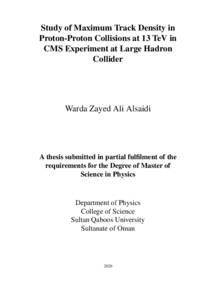Document
Study of maximum track density in proton-proton collisions at 13 TeV in CMS experiment at large hadron collider.
Publisher
Sultan Qaboos University.
Gregorian
2020
Language
English
English abstract
The track multiplicity distribution of emitted charged particles in the
collisions of hadrons is one of the observables for understanding multiparticle production in proton-proton collisions at high energy. It imposes some important constraints in the particle production mechanisms. It has
been the subject of experimental and theoretical studies and provides essential information on the dynamics of strong interactions.
This work covers the measurements of maximum track densities on
the data recorded in proton-proton collisions at the center of mass energy √
s =13 TeV using the Compact Muon Solenoid (CMS) detector at
the Large Hadron Collider (LHC) at European Organization for Nuclear
Research (CERN). The proton-proton data set from RunII (2015C) with
8.93 × 107
events were analyzed. The measurements were performed using high multiplicity events which were collected in the High Multiplicity
Trigger. The main goal is to make comparisons between the results obtained previously at a low center of mass-energy and higher energy for the
maximum track density per event inside a small window with width 0.1,
0.2, and 0.5 with respect to pseudorapidity to check if there is any irregularity.
In order to reject secondaries and background processes a selection was
applied to the data. The maximum track density, <
dndη >max, distributions within several pseudorapidity windows (∆η = 0.1, 0.2 and 0.5) were analyzed. It was found to be larger in a smaller window ∆η = 0.1 when compared with the larger windows. The results show that the maximum
charged particle density per given pseudorapidity interval increases linearly with track multiplicity.
Member of
Resource URL
Category
Theses and Dissertations

